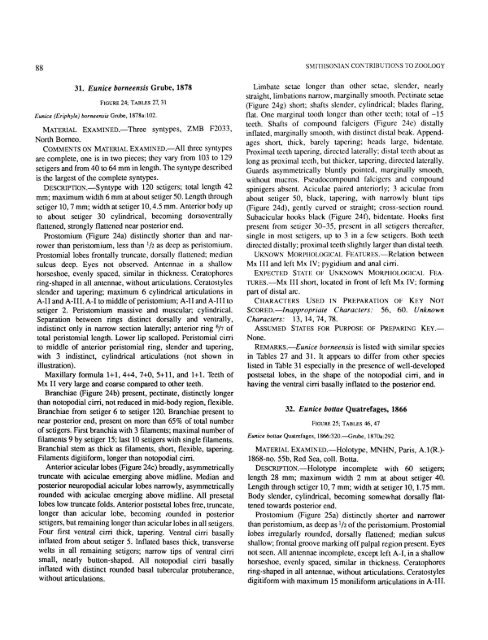A Review of the Genus Eunice - Smithsonian Institution Libraries
A Review of the Genus Eunice - Smithsonian Institution Libraries
A Review of the Genus Eunice - Smithsonian Institution Libraries
Create successful ePaper yourself
Turn your PDF publications into a flip-book with our unique Google optimized e-Paper software.
88 SMITHSONIAN CONTRIBUTIONS TO ZOOLOGY<br />
31. <strong>Eunice</strong> borneensis Grube, 1878<br />
FIGURE 24; TABLES 27, 31<br />
<strong>Eunice</strong> (Eriphyle) borneensis Grube, 1878a: 102.<br />
MATERIAL EXAMINED.—Three syntypes, ZMB F2033,<br />
North Borneo.<br />
COMMENTS ON MATERIAL EXAMINED.—All three syntypes<br />
are complete, one is in two pieces; <strong>the</strong>y vary from 103 to 129<br />
setigers and from 40 to 64 mm in length. The syntype described<br />
is <strong>the</strong> largest <strong>of</strong> <strong>the</strong> complete syntypes.<br />
DESCRIPTION.—Syntype with 120 setigers; total length 42<br />
mm; maximum width 6 mm at about setiger 50. Length through<br />
setiger 10,7 mm; width at setiger 10,4.5 mm. Anterior body up<br />
to about setiger 30 cylindrical, becoming dorsoventrally<br />
flattened, strongly flattened near posterior end.<br />
Prostomium (Figure 24a) distinctly shorter than and narrower<br />
than peristomium, less than x li as deep as peristomium.<br />
Prostomial lobes frontally truncate, dorsally flattened; median<br />
sulcus deep. Eyes not observed. Antennae in a shallow<br />
horseshoe, evenly spaced, similar in thickness. Ceratophorcs<br />
ring-shaped in all antennae, without articulations. Ceratostyles<br />
slender and tapering; maximum 6 cylindrical articulations in<br />
A-II and A-111. A-I to middle <strong>of</strong> peristomium; A-II and A-111 to<br />
setiger 2. Peristomium massive and muscular; cylindrical.<br />
Separation between rings distinct dorsally and ventrally,<br />
indistinct only in narrow section laterally; anterior ring 6 /i <strong>of</strong><br />
total peristomial length. Lower lip scalloped. Peristomial cirri<br />
to middle <strong>of</strong> anterior peristomial ring, slender and tapering,<br />
with 3 indistinct, cylindrical articulations (not shown in<br />
illustration).<br />
Maxillary formula 1+1, 4+4, 7+0, 5+11, and 1+1. Teeth <strong>of</strong><br />
Mx II very large and coarse compared to o<strong>the</strong>r teeth.<br />
Branchiae (Figure 24b) present, pectinate, distinctly longer<br />
than notopodial cirri, not reduced in mid-body region, flexible.<br />
Branchiae from setiger 6 to setiger 120. Branchiae present to<br />
near posterior end, present on more than 65% <strong>of</strong> total number<br />
<strong>of</strong> setigers. First branchia with 3 filaments; maximal number <strong>of</strong><br />
filaments 9 by setiger 15; last 10 setigers with single filaments.<br />
Branchial stem as thick as filaments, short, flexible, tapering.<br />
Filaments digitiform, longer than notopodial cirri.<br />
Anterior acicular lobes (Figure 24c) broadly, asymmetrically<br />
truncate with aciculae emerging above midline. Median and<br />
posterior neuropodial acicular lobes narrowly, asymmetrically<br />
rounded with aciculae emerging above midline. All presetal<br />
lobes low truncate folds. Anterior postsetal lobes free, truncate,<br />
longer than acicular lobe, becoming rounded in posterior<br />
setigers, but remaining longer than acicular lobes in all setigers.<br />
Four first ventral cirri thick, tapering. Ventral cirri basally<br />
inflated from about setiger 5. Inflated bases thick, transverse<br />
welts in all remaining setigers; narrow tips <strong>of</strong> ventral cirri<br />
small, nearly button-shaped. All notopodial cirri basally<br />
inflated with distinct rounded basal tubercular protuberance,<br />
without articulations.<br />
Limbate setae longer than o<strong>the</strong>r setae, slender, nearly<br />
straight, limbations narrow, marginally smooth. Pectinate setae<br />
(Figure 24g) short; shafts slender, cylindrical; blades flaring,<br />
fiat. One marginal tooth longer than o<strong>the</strong>r teeth; total <strong>of</strong> -15<br />
teeth. Shafts <strong>of</strong> compound falcigcrs (Figure 24e) distally<br />
inflated, marginally smooth, with distinct distal beak. Appendages<br />
short, thick, barely tapering; heads large, bidentate.<br />
Proximal teeth tapering, directed laterally; distal teeth about as<br />
long as proximal teeth, but thicker, tapering, directed laterally.<br />
Guards asymmetrically bluntly pointed, marginally smooth,<br />
without mucros. Pscudocompound falcigcrs and compound<br />
spinigers absent. Aciculae paired anteriorly; 3 aciculae from<br />
about setiger 50, black, tapering, with narrowly blunt tips<br />
(Figure 24d), gently curved or straight; cross-section round.<br />
Subacicular hooks black (Figure 241), bidentate. Hooks first<br />
present from sctigcr 30-35, present in all setigers <strong>the</strong>reafter,<br />
single in most setigers, up to 3 in a few sctigcrs. Both teeth<br />
directed distally; proximal teeth slightly larger than distal teeth.<br />
UKNOWN MORPHOLOGICAL FEATURES.—Relation between<br />
Mx III and left Mx IV; pygidium and anal cirri.<br />
EXPECTED STATE OF UNKNOWN MORPHOLOGICAL FEA-<br />
TURES.—Mx III short, located in front <strong>of</strong> left Mx IV; forming<br />
part <strong>of</strong> distal arc.<br />
CHARACTERS USED IN PREPARATION OF KEY NOT<br />
SCORED.—Inappropriate Characters: 56, 60. Unknown<br />
Characters: 13,14,74,78.<br />
ASSUMED STATES FOR PURPOSE OF PREPARING KEY.—<br />
None.<br />
REMARKS.—<strong>Eunice</strong> borneensis is listed with similar species<br />
in Tables 27 and 31. It appears to differ from o<strong>the</strong>r species<br />
listed in Table 31 especially in <strong>the</strong> presence <strong>of</strong> well-developed<br />
postsetal lobes, in <strong>the</strong> shape <strong>of</strong> <strong>the</strong> notopodial cirri, and in<br />
having <strong>the</strong> ventral cirri basally inflated to <strong>the</strong> posterior end.<br />
32. <strong>Eunice</strong> bottae Quatrefages, 1866<br />
FIGURE 25; TABLES 46,47<br />
<strong>Eunice</strong> bottae Quatrefages, 1866:320.—Grube, 1870a:292.<br />
MATERIAL EXAMINED.—Holotype, MNHN, Paris, A.1(R.)-<br />
1868-no. 55b, Red Sea, coll. Botta.<br />
DESCRIPTION.—Holotype incomplete with 60 setigers;<br />
length 28 mm; maximum width 2 mm at about setiger 40.<br />
Length through setiger 10,7 mm; width at setiger 10,1.75 mm.<br />
Body slender, cylindrical, becoming somewhat dorsally flattened<br />
towards posterior end.<br />
Prostomium (Figure 25a) distinctly shorter and narrower<br />
than peristomium, as deep as '/2 <strong>of</strong> <strong>the</strong> peristomium. Prostomial<br />
lobes irregularly rounded, dorsally flattened; median sulcus<br />
shallow; frontal groove marking <strong>of</strong>f palpal region present. Eyes<br />
not seen. All antennae incomplete, except left A-I, in a shallow<br />
horseshoe, evenly spaced, similar in thickness. Ceratophores<br />
ring-shaped in all antennae, without articulations. Ceratostyles<br />
digitiform with maximum 15 moniliform articulations in A-I 11.
















